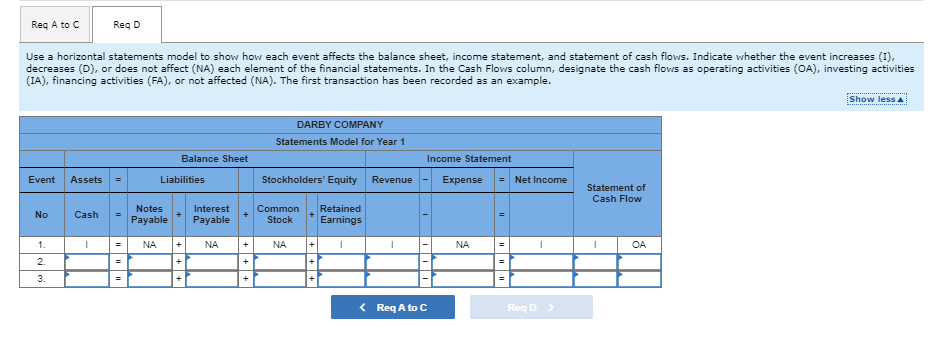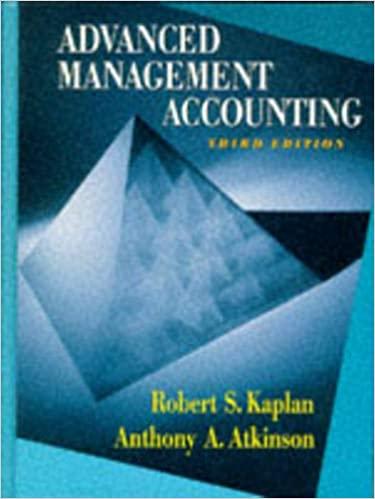

Exercise 9-2A Effects of recognizing accrued Interest on financial statements LO 9-1 Bill Darby started Darby Company on January 1. Year 1. The company experienced the following events during its first year of operation: 1. Eamed $1.100 of cash revenue. 2. Borrowed $2,800 cash from the bank. 3. Adjusted the accounting records to recognize accrued interest expense on the bank note. The note, issued on September 1, Year 1. had a one-year term and an 6 percent annual interest rate. Required: a. What is the amount of interest payable at December 31, Year 1? b. What is the amount of interest expense in Year 1? c. What is the amount of interest paid in Year 1? d. Use a horizontal statements model to show how each event affects the balance sheet, income statement, and statement of cash flows. Indicate whether the event increases (I). decreases (D), or does not affect (NA) each element of the financial statements. In the Cash Flows column, designate the cash flows as operating activities (OA), investing activities (IA), financing activities (FA), or not affected (NA). The first transaction has been recorded as an example. Complete this question by entering your answers in the tabs below. Reg A to C ReqD What is the amount of interest payable at December 31, Year 1? (Do not round intermediate calculations. Round your answer to the nearest dollar amount.) What is the amount of interest expense in Year 1? (Do not round intermediate calculations. Round your answer to the nearest dollar amount.) What is the amount of interest paid in Year 1? a. b. Interest payable Interest expense Amount of cash paid Reg A to C Reg D Use a horizontal statements model to show how each event affects the balance sheet, income statement, and statement of cash flows. Indicate whether the event increases (1), decreases (D), or does not affect (NA) each element of the financial statements. In the Cash Flows column, designate the cash flows as operating activities (OA), investing activities (IA), financing activities (FA), or not affected (NA). The first transaction has been recorded as an example. Show less . DARBY COMPANY Statements Model for Year 1 Balance Sheet Income Statement Event Assets Liabilities Stockholders' Equity Revenue Expense = Net Income Statement of Cash Flow Common No Cash Notes Payable Interest Payable Retained Earnings - Stock + 1. 1 = NA + NA + NA 1 NA + 2. 3. = + + + = Reg A to C Reg D Use a horizontal statements model to show how each event affects the balance sheet, income statement, and statement of cash flows. Indicate whether the event increases (1), decreases (D), or does not affect (NA) each element of the financial statements. In the Cash Flows column, designate the cash flows as operating activities (OA), investing activities (IA), financing activities (FA), or not affected (NA). The first transaction has been recorded as an example. Show less . DARBY COMPANY Statements Model for Year 1 Balance Sheet Income Statement Event Assets Liabilities Stockholders' Equity Revenue Expense = Net Income Statement of Cash Flow Common No Cash Notes Payable Interest Payable Retained Earnings - Stock + 1. 1 = NA + NA + NA 1 NA + 2. 3. = + + + =








